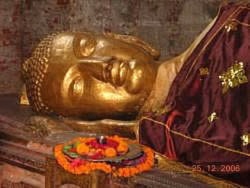Difference between revisions of "Jnanaprasthana"
| (One intermediate revision by the same user not shown) | |||
| Line 2: | Line 2: | ||
<poem> | <poem> | ||
[[File:Sb9.jpg|thumb|250px|]] | [[File:Sb9.jpg|thumb|250px|]] | ||
| − | [[Jnanaprasthana]] or [[Jnanaprasthana-sastra]], composed by [[Katyayaniputra]] is one of the seven [[Sarvastivada]] [[Abhidharma]] [[Buddhist scriptures]]. [[Jnanaprasthana]] means "[[establishment of knowledge]]" [[Jnanaprasthana]] was translated into {{Wiki|Chinese}} by [[Xuanzang]], T26, No. 1544, in 20 fascicles. It also appears under the [[name]] [[Astaskandha-sastra]] in the [[Taisho]], with the translation by [[Samghadeva]], [[Zhu-fo—nian]] and [[Dharmapriya]]: T26, No. 1543 in a slightly larger 30 fascicles. There is a slight difference in format of the two, perhaps indicating that they are different recensions from various sub-schools of the [[Sarvastivada]]. The [[tradition]] of the [[Mahavibhasa]] states that it was taught by the [[Buddha]] himself, but differs as to the circumstances. It was later [[Katyayaniputra]] who was responsible for the compilation thereof. The [[Maha-prajna-paramitopadesa]] (which actually refers to the [[Astaskandha]]) states that 100 years after the [[Buddha's]] demise, there arose [[doctrinal]] disputes among the great [[masters]], giving rise to distinctly named schools. [[Xuanzang]] maintained that it was written some three centuries after the [[Buddha]], which would be c. 150 BCE. The {{Wiki|orthodox}} [[Vibhāṣa]] takes this as the ‘[[root]]’ [[Abhidharma]], though references are sometimes made to the [[Prakaraṇapāda]] in the same terms. It became known as the ‘[[body]]’ of the [[Abhidharma]], with the six remaining texts of the early period known as the ‘{{Wiki|legs}}’ or ‘supports’. This is based on textual authority, and not a temporal definition, given the respective historical [[order]] of these seven treatises. That is, the [[Jñānaprasthāna]] is not sourced from the six {{Wiki|legs}}, but neither is it directly sourced from the [[sūtras]]. This is also a reminder that these texts were all probably in a state of [[constant]] revision and update, for possibly several hundred years. There are thus mutual reference and borrowing of format and content, that cannot be summarily described by a simply sequential [[order]]. The outline of the text more closely approximates that earliest of models, the [[Sariputra]] [[Abhidharma]], than those specifically [[Sarvastivada]] treatises. This is evidenced in its use of the [[samyojanas]], [[prajna]], [[karma]], [[indriya]], [[mahabhuta]], [[dhyana]] and [[drsti]] as main divisions. A similar system is later continued through into the [[Kosa]], and [[Hrdaya]] texts. Prior to this is a division of "assorted issues". The {{Wiki|analysis}} is of three main types, according to [[Yinshun]]: | + | [[Jnanaprasthana]] or [[Jnanaprasthana-sastra]], composed by [[Katyayaniputra]] is one of the seven [[Sarvastivada]] [[Abhidharma]] [[Buddhist scriptures]]. [[Jnanaprasthana]] means "[[establishment of knowledge]]" [[Jnanaprasthana]] was translated into {{Wiki|Chinese}} by [[Xuanzang]], T26, No. 1544, in 20 fascicles. It also appears under the [[name]] [[Astaskandha-sastra]] in the [[Taisho]], with the translation by [[Samghadeva]], [[Zhu-fo—nian]] and [[Dharmapriya]]: T26, No. 1543 in a slightly larger 30 fascicles. There is a slight difference in format of the two, perhaps indicating that they are different recensions from various sub-schools of the [[Sarvastivada]]. The [[tradition]] of the [[Mahavibhasa]] states that it was [[taught]] by the [[Buddha]] himself, but differs as to the circumstances. It was later [[Katyayaniputra]] who was responsible for the compilation thereof. The [[Maha-prajna-paramitopadesa]] (which actually refers to the [[Astaskandha]]) states that 100 years after the [[Buddha's]] demise, there arose [[doctrinal]] [[disputes]] among the great [[masters]], giving rise to distinctly named schools. [[Xuanzang]] maintained that it was written some three centuries after the [[Buddha]], which would be c. 150 BCE. The {{Wiki|orthodox}} [[Vibhāṣa]] takes this as the ‘[[root]]’ [[Abhidharma]], though references are sometimes made to the [[Prakaraṇapāda]] in the same terms. It became known as the ‘[[body]]’ of the [[Abhidharma]], with the six remaining texts of the early period known as the ‘{{Wiki|legs}}’ or ‘supports’. This is based on textual authority, and not a {{Wiki|temporal}} [[definition]], given the respective historical [[order]] of these [[seven treatises]]. That is, the [[Jñānaprasthāna]] is not sourced from the six {{Wiki|legs}}, but neither is it directly sourced from the [[sūtras]]. This is also a reminder that these texts were all probably in a [[state]] of [[constant]] revision and update, for possibly several hundred years. There are thus mutual reference and borrowing of format and content, that cannot be summarily described by a simply sequential [[order]]. The outline of the text more closely approximates that earliest of models, the [[Sariputra]] [[Abhidharma]], than those specifically [[Sarvastivada]] treatises. This is evidenced in its use of the [[samyojanas]], [[prajna]], [[karma]], [[indriya]], [[mahabhuta]], [[dhyana]] and [[drsti]] as main divisions. A similar system is later continued through into the [[Kosa]], and [[Hrdaya]] texts. Prior to this is a [[division]] of "assorted issues". The {{Wiki|analysis}} is of three main types, according to [[Yinshun]]: |
| − | {{Wiki|Analysis}} of the [[sutras]] themselves – in [[order]] to find the actual underlying [[principle]], rather than acceptance of the content at face value, which could lead to apparent contradiction. This indicates the [[Abhidharmika]] standpoint of taking the [[Abhidharma]] as [[pramana]] in [[understanding]] the [[doctrine]]. | + | {{Wiki|Analysis}} of the [[sutras]] themselves – in [[order]] to find the actual underlying [[principle]], rather than [[acceptance]] of the content at face value, which could lead to apparent {{Wiki|contradiction}}. This indicates the [[Abhidharmika]] standpoint of taking the [[Abhidharma]] as [[pramana]] in [[understanding]] the [[doctrine]]. |
| − | {{Wiki|Analysis}} of the {{Wiki|nature}}, or {{Wiki|characteristics}}, of {{Wiki|individual}} [[dharmas]]. Rather than the use of [[sūtra]] categories pertaining to [[spiritual]] praxis, the tendency here is to group by type. Thus, [[dharmas]] are assigned as either [[rūpa]], [[citta]], [[caitasika]] or [[citta-viprayukta]] – the [[conditioned]] [[dharmas]], and also the [[unconditioned]] [[dharmas]]. Specifics as to each type are given, as well as detailed discussions of related [[dharmas]]. These are then again categorized according to their being with or without [[outflows]]; [[visible]] or non-visible; past, present or future; as to [[realm]]; and so forth. | + | {{Wiki|Analysis}} of the {{Wiki|nature}}, or {{Wiki|characteristics}}, of {{Wiki|individual}} [[dharmas]]. Rather than the use of [[sūtra]] categories pertaining to [[spiritual]] praxis, the tendency here is to group by type. Thus, [[dharmas]] are assigned as either [[rūpa]], [[citta]], [[caitasika]] or [[citta-viprayukta]] – the [[conditioned]] [[dharmas]], and also the [[unconditioned]] [[dharmas]]. Specifics as to each type are given, as well as detailed discussions of related [[dharmas]]. These are then again categorized according to their being with or without [[outflows]]; [[visible]] or non-visible; {{Wiki|past}}, {{Wiki|present}} or {{Wiki|future}}; as to [[realm]]; and so forth. |
| − | {{Wiki|Analysis}} of the relationship between various [[dharmas]]. As the preceding {{Wiki|analysis}} lends itself to plurality, and the possibility of falling into independent [[Saṃkhya]]-type [[realities]], this {{Wiki|analysis}} completes the [[Buddhist]] [[teaching]] of [[dependent origination]], preventing such an error. Using [[kṣanika]] {{Wiki|theory}}, it establishes the six-fold conditionality {{Wiki|theory}}, that would later be a special feature of the [[Sarvāstivāda]]. This is the earliest text in which the {{Wiki|theory}} appears. It also includes some detail on [[citta-viprayukta-dharmas]]. | + | {{Wiki|Analysis}} of the relationship between various [[dharmas]]. As the preceding {{Wiki|analysis}} lends itself to plurality, and the possibility of falling into {{Wiki|independent}} [[Saṃkhya]]-type [[realities]], this {{Wiki|analysis}} completes the [[Buddhist]] [[teaching]] of [[dependent origination]], preventing such an error. Using [[kṣanika]] {{Wiki|theory}}, it establishes the six-fold [[conditionality]] {{Wiki|theory}}, that would later be a special feature of the [[Sarvāstivāda]]. This is the earliest text in which the {{Wiki|theory}} appears. It also includes some detail on [[citta-viprayukta-dharmas]]. |
| − | The influence of the [[Vijnanaprasthana]] is seen strongly in the [[Vibhasa]], and this influenced the subsequent [[Hrdaya]] texts, and also the Kosa and commentaries. | + | The influence of the [[Vijnanaprasthana]] is seen strongly in the [[Vibhasa]], and this influenced the subsequent [[Hrdaya]] texts, and also the [[Kosa]] and commentaries. |
</poem> | </poem> | ||
{{R}} | {{R}} | ||
[http://www.tamqui.com/buddhaworld/Jnanaprasthana www.tamqui.com] | [http://www.tamqui.com/buddhaworld/Jnanaprasthana www.tamqui.com] | ||
[[Category:Sarvāstivāda]] | [[Category:Sarvāstivāda]] | ||
Latest revision as of 20:07, 6 November 2015
Jnanaprasthana or Jnanaprasthana-sastra, composed by Katyayaniputra is one of the seven Sarvastivada Abhidharma Buddhist scriptures. Jnanaprasthana means "establishment of knowledge" Jnanaprasthana was translated into Chinese by Xuanzang, T26, No. 1544, in 20 fascicles. It also appears under the name Astaskandha-sastra in the Taisho, with the translation by Samghadeva, Zhu-fo—nian and Dharmapriya: T26, No. 1543 in a slightly larger 30 fascicles. There is a slight difference in format of the two, perhaps indicating that they are different recensions from various sub-schools of the Sarvastivada. The tradition of the Mahavibhasa states that it was taught by the Buddha himself, but differs as to the circumstances. It was later Katyayaniputra who was responsible for the compilation thereof. The Maha-prajna-paramitopadesa (which actually refers to the Astaskandha) states that 100 years after the Buddha's demise, there arose doctrinal disputes among the great masters, giving rise to distinctly named schools. Xuanzang maintained that it was written some three centuries after the Buddha, which would be c. 150 BCE. The orthodox Vibhāṣa takes this as the ‘root’ Abhidharma, though references are sometimes made to the Prakaraṇapāda in the same terms. It became known as the ‘body’ of the Abhidharma, with the six remaining texts of the early period known as the ‘legs’ or ‘supports’. This is based on textual authority, and not a temporal definition, given the respective historical order of these seven treatises. That is, the Jñānaprasthāna is not sourced from the six legs, but neither is it directly sourced from the sūtras. This is also a reminder that these texts were all probably in a state of constant revision and update, for possibly several hundred years. There are thus mutual reference and borrowing of format and content, that cannot be summarily described by a simply sequential order. The outline of the text more closely approximates that earliest of models, the Sariputra Abhidharma, than those specifically Sarvastivada treatises. This is evidenced in its use of the samyojanas, prajna, karma, indriya, mahabhuta, dhyana and drsti as main divisions. A similar system is later continued through into the Kosa, and Hrdaya texts. Prior to this is a division of "assorted issues". The analysis is of three main types, according to Yinshun:
Analysis of the sutras themselves – in order to find the actual underlying principle, rather than acceptance of the content at face value, which could lead to apparent contradiction. This indicates the Abhidharmika standpoint of taking the Abhidharma as pramana in understanding the doctrine.
Analysis of the nature, or characteristics, of individual dharmas. Rather than the use of sūtra categories pertaining to spiritual praxis, the tendency here is to group by type. Thus, dharmas are assigned as either rūpa, citta, caitasika or citta-viprayukta – the conditioned dharmas, and also the unconditioned dharmas. Specifics as to each type are given, as well as detailed discussions of related dharmas. These are then again categorized according to their being with or without outflows; visible or non-visible; past, present or future; as to realm; and so forth.
Analysis of the relationship between various dharmas. As the preceding analysis lends itself to plurality, and the possibility of falling into independent Saṃkhya-type realities, this analysis completes the Buddhist teaching of dependent origination, preventing such an error. Using kṣanika theory, it establishes the six-fold conditionality theory, that would later be a special feature of the Sarvāstivāda. This is the earliest text in which the theory appears. It also includes some detail on citta-viprayukta-dharmas.
The influence of the Vijnanaprasthana is seen strongly in the Vibhasa, and this influenced the subsequent Hrdaya texts, and also the Kosa and commentaries.

